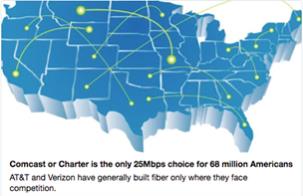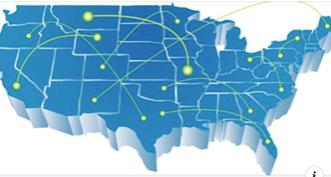Comcast’s broadband subscribers included 25.5 million households, or about 64.8 million people, based on the average US household size of 2.54 people.
Charter, the second biggest cable company after Comcast, offers service to 101 million people in 45 states. 22.5 million households covering about 57.2 million people were subscribing to Charter Internet, according to the numbers cited by the ILSR.
Like Comcast, Charter offers broadband-level speeds throughout its territory. “About 38 million [people in Charter territory] have no other option for broadband service,” the report said.
Comcast and Charter generally don’t compete against each other. They have a combined territory covering about 210 million people, yet the companies’ overlapping service territory covers only about 1.5 million people, according to the Form 477 data cited by the ILSR. The overlap is mostly in Florida, where Charter purchased Bright House Networks, and may be overstated because an entire census block is counted as served even if an ISP offers service to just one resident in the block.
AT&T, Verizon, and other telcos
The numbers look a lot different when you switch from cable to DSL and fiber providers. AT&T is the biggest such provider, offering Internet service to 122.5 million people in 21 states. But nearly all of that is DSL orfiber-to-the-node, as AT&T was offeringfiber-to-the-home to just 7.8 million people as of the December 2016 data, the ILSR report said.
The report continues: “About 53.7 percent of people (65.8 million) in the total service area have access to broadband-level service through AT&T. Of these people, 745,000 have no other option for broadband service. The data suggests that AT&T has almost exclusively upgraded its networks to offer broadband-level service only in areas where it faces competition.”
In other words, AT&T has installed fiber or at least broadband-level speeds in many areas where it competes against cable companies, but it generally hasn’t bothered to do so in areas without competition.
Verizon, meanwhile, offers Internet service to 55.2 million people. “The DSL service area covers 47.7 million people, but the FTTH(fiber-to-the-home) service area covers 33.3 million people,” with significant overlap, the report said.
About 33.5 million people have access to broadband speeds from Verizon. Of those, “approximately 185,000 people have no other option for broadband service,” the report says. “This means that FiOS has almost exclusively been deployed to areas where it faces cable competition.” Verizon had 7 million households subscribing to its Internet service.
The report also covers CenturyLink and Frontier. CenturyLink offers Internet service to 49.1 million people, but itsfiber-to-the-home service is only available to 3.8 million.
“About 47.9 percent of people (23.5 million) in the total service area have access to broadband-level service through CenturyLink and approximately 1 million people have no other option for broadband service,” the report said.
CenturyLink’s subscribers include about 5 million households covering about 12.7 million people.
Frontier’s DSL service area covers 30 million Americans, while itsfiber-to-the-home territory covers 10 million people.
“About 38.7 percent of people (12.6 million) in this service area have access to broadband-level service through Frontier,” the report said. “Approximately 59,000 people have no other option for broadband service. These data suggest that Frontier has invested in faster services almost solely where it faces competition and not in more rural areas.”

